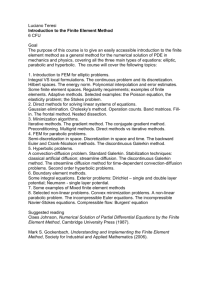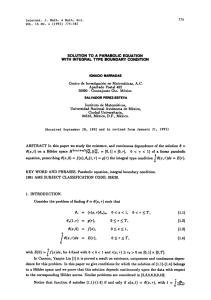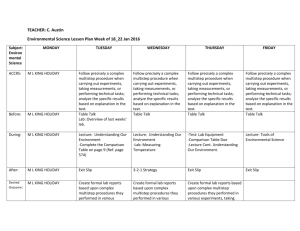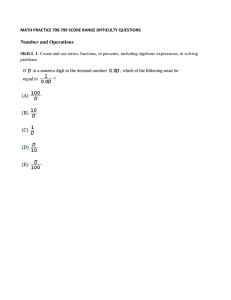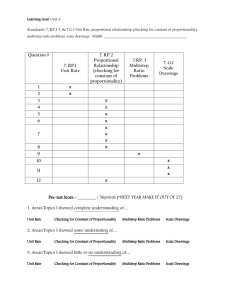LINEAR IN PROCEDURES UNIFORM STABILITY OF
advertisement
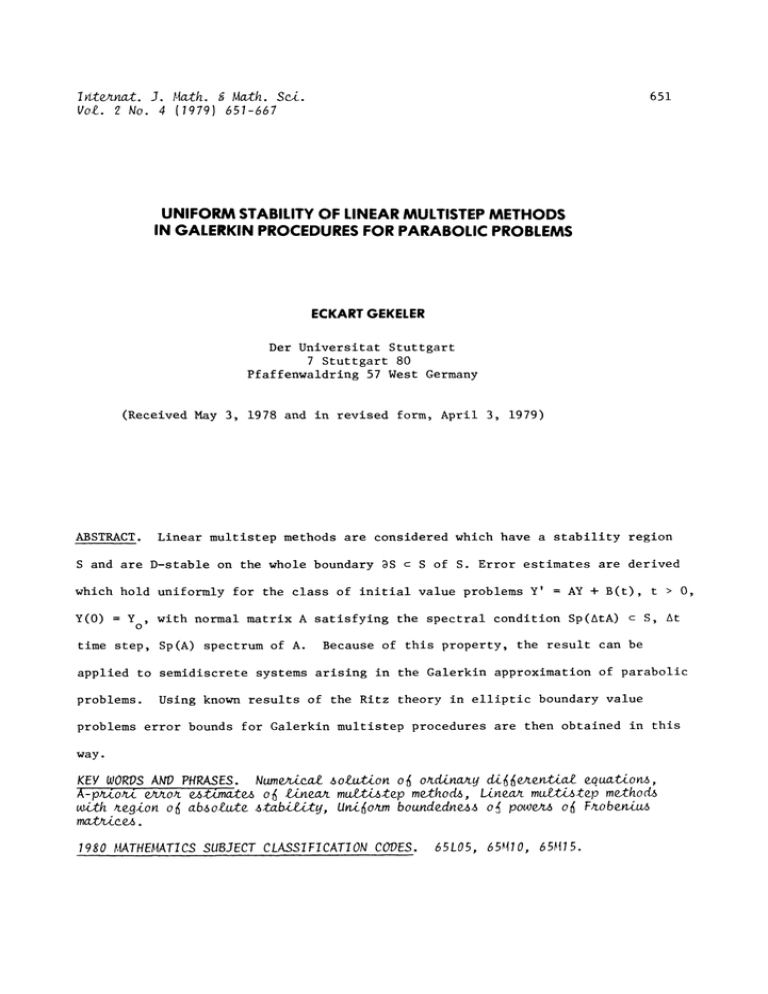
Iternat. J. ath. & Math. Sci.
Vol. 2 No. 4 (1979) 651-667
651
UNIFORM STABILITY OF LINEAR MULTISTEP METHODS
IN GALERKIN PROCEDURES FOR PARABOLIC PROBLEMS
ECKART GEKELER
Der Universitat Stuttgart
7 Stuttgart 80
Pfaffenwaldring 57 West Germany
(Received May 3, 19 78 and in revised form, April 3, 1979)
ABSTRACT.
Linear multistep methods are considered which have a stability region
S and are D-stable on the whole boundary S
c
S of S. Error estimates are derived
which hold uniformly for the class of initial value problems
Y(0)
Y
O
Y’
AY + B(t), t
with normal matrix A satisfying the spectral condition Sp(AtA)
time step, Sp(A) spectrum of A.
S
>
0,
At
Because of this property, the result can be
applied to semidiscrete systems arising in the Galerkin approximation of parabolic
problems.
Using known results of the Ritz theory in elliptic boundary value
problems error bounds for Galerkin multistep procedures are then obtained in this
way.
KEY WORDS AND PHRASES. Numerical solution of ordinary differential equation,
A-pror error estimates of linear mtistep methods, Linear mbistep methods
with region of absolute stability, Uniform boundedness of powers of Frobenius
matrices.
1980 MATHEATICS SUBJECT CLASSIFICATION CODES.
65L05, 6510, 6515.
E. GEKELER
652
INTRODUCTION
If a linear parabolic initial boundary value problem is descretized in the
space dimensions by the finite element method then the resulting semidiscrete
problem is an initial value problem for a system of ordinary differential equations:
M(Ax)U t + K(Ax)U
P(t),
t
>
O, U(O)
UO,
(I)
see e.g. Strang and Fix [!9]. In the nomenclature of matrix structural analysis,
P(t) is the external load vector, M(Ax) the mass matrix, and K(Ax) the stiffness
matrix; cf. e.g. Bathe and Wilson [2] and Przemieniecki [!5]. In the present communication both matrices are supposed to be independent of the time t, real symmetric and positive definite. They depend together with their dimension on the
small parameter
Ax which is,
in general, the maximum diameter of all elements in
the finite element subspace; see e.g.
[2, !5, !9].
The condition number of M(Ax),
-I/2
M(Ax)
IIM(Ax)II 2 IIM(Ax) -! 2 depends not on Ax but for L(Ax)
-I/2 we find cond(L(Ax))
2 or j
4 respectively if
!/Ax j with j
K(Ax)M(Ax)
cond(M(Ax))
the elliptic operator
in the analytic problem is of order two or four, cf.e.g.
Strang and Fix [19, ch. 5]. These properties follow in a natural way since the
finite-dimensional operator L must be an approximation to the analytical operator
As a consequence the problem (!) becomes very stiff if a small mesh width Ax
is chosen.
Linear multistep methods were frequently proposed for the solution of stiff
problems, cf. e.g. Lambert [|O]. Their application to systems of the form
(|)
was studied for instance by Descloux [5], Zlamal [23, 24], and Gekeler [6, 7].
Apart from the drawback to need a special starting procedure, (one-stage) multistep methods have two advantageous properties in comparison with multistage
(one-step) methods (io e. Runge-Kutta methods etc.
The order of the discretization error is not negatively affected if the
mesh width
Ax becomes small.
653
UNIFORM STABILITY FOR PARABOLIC PROBLEMS
The linear system of equations to be solved in every time step of an impli-
cit multistep method has the simple form (M(Ax)
/
AtK(Ax))Y
C, At time
step.
The aim of this paper is to show that the stability of linear multistep
approximations to (1), too, remains unaffected by the space discretization if
the below defined spectral condition is satisfied. This condition implies no
restriction of the relation between At and Ax if the multistep method is
Ao-stable
(definition below).
In the last section we apply our estimates to Galerkin multistep discretizations of parabolic initial boundary problems and show that the order of con-
sistence is the order of convergence in this class of numerical approximations.
The results improve some of our error bounds derived in [6] where exponential
stability was not yet obtained.
An other goal of the present contribution was to obtain error estimates in
a form which is applicable to multistep methods in systems of second order. In
a subsequent paper we use our results and consider Galerkin multistep discreti-
zations of hyperbolic initial boundary value problems. The error estimates deduced there correspond to a high degree to those established here for parabolic
problems.
2.
UNIFORM STABILITY.
To introduce linear multistep methods let
p()
_k-
.k
.=Og
sO > O, ()
r,
k=O k-, O > O,
be two real polynomials without common roots (including zero). Let At be a small
increment of time t,
(TY)(t)
Y(t+At), T
value problem
Yn
Y(nAt), and let the shift operator T be defined by
TT -I Then a linear k-step method <p,> for the initial
E. GEKELER
654
Y’
AY + B(t), t > O, Y(O)
(2)
YO’
is formally defined by
AtA(T)Vn + At(T)Bn
0(T)Vn
Here the starting values
n
(3)
O,|,
are assumed to be known. If we apply the
VO,...,Vk_
scheme <0,> to (I) then we obtain
M(Ax)0(T)Vn + AtK(Ax)cI(T)Vn
At(T)P n
n
(3’)
O,I
By the linearity of the multistep method this relation is equivalent to (3) if
L(Ax) and replace M(Ax)
we set A
DEFINITION I.
Let O <
I/2Vn
by Vn again.
.
(Cf. Stetter [17, Def. 4.1.7], Lambert [IO, ch. 2].)
be a fixed constant and 0 < At <
A linear multistep method <0,>
is consistent if there exists a positive integer q called the order of <0,>
such that the truncation error (or defect)
d<p,o >(At,w) (t)
At((T)w’ (t)
p(T)w(t)
satisfies
for all w E
+I
Id<o,>(At,w)(t)
(), where < depends
on t,
<<At q+|
,
and w but not on At.
A method <0,> is consistent if and only if the following conditions are
fulfilled:
p()
see e.g. Lambert
[10, p.30].
is due to Dahlquist
LEMMA I.
0, 0’(1)
o(1)
(4)
The following estimation of the truncation error
[4, ch.4];
see also Lambert
[10,
3.3].
If the linear multistep method <p,d> is consistent of order q
then
IId<0,>(At,w)(t)ll
for all W
E C q+!(), where
< cmaXtATL_t+kAt
w(q+l)(T)II Atq+l
depends on the data of <p,d>
but not on t,
At, W,
and the norm.
Let now
way, let
be the complex plane extended by the point
in the usual
655
UNIFORM STABILITY FOR PARABOLIC PROBLEMS
no(;), (;,)
p(;)
(;,n)
be the characteristic polynomial of the method <0,> and let Sp(A) be the spectrum of the matrix A. As well-known, the concept of absolute stability plays a
fundamental role in the numerical solution of stiff differential equations. How-
ever, there exists no method <0,> of order q > 2 which is A-stable in the sense
of Dahlquist, see e.g. Stetter
[17,
Def. 2.3.13, Th. 4.6.6]. Therefore Odeh and
Liniger [13] weakened the requirement of A-stability in the following way.
DEFINITION 2.
E G
A method <0,> is
=
implies
A method <0,> is said
ll
<
AG-Stable
if G
and
#
of
for all roots
to be D-stable if no root of the
(,)
0()
polynomial (,O)
has modulus greater than one and every root with modulus one is simple. It is
is the only root of 0() with
strongly D-stable if it is D-stable and
dulus one. In a D-stable method <0,> the roots
called essential roots of 0(), the quantity
with an essential root
Th 4.6.4]
AG-Stable
of 0() with modulus one are
X ()/(0’())
associated
of 0() is called the growth parameter of
D-stable and consistent method <0,> is
AG-Stable
.
too-
if all
ReX
A
> O, cf. e.g. [17,
Especially, every consistent and strongly D-stable method <0,> is
with G including the negative real line in a neighborhood of the ori-
gin since the essential root
If a method <0,> is
I
AG-Stable
has the growth parameter X
I.
then the numerical approximation of (2) ob-
tained by (3) is exponentially stable for every fixed matrix A and fixed time
step At if Sp(AtA)
=
G, cf. e.g. [17, Th. 4.6.3]. But in the present communica-
tion we consider an entire class of initial value problems (2) thus Sp(AtA) can
be arbitrary close to the whole boundary G of G where
ment- roots of
small
At then G
by a continuity argu-
(,) can have modulus one. (Moreover, if
we admit an arbitrary
must contain the negative real line in a neighborhood of the
origin, i.e., 0 E G.) Therefore we must require that <0,o> is D-stable on Gand not only in the origin. The next definition was also used by Nevanlinna [12].
E. GEKELER
656
DEFINITION 3.
E
The stability region S of a method <0,> consists of those
for which all roots of
(,D) satisfy
lI
<
and those of modulus one are
simp le.
Obviously, an
AG-Stable
method <0,(I> has the stability region S
G. With
this notation the below needed spactral condition can now be written as follows.
DEFINITION 4.
At, and
The method <0,>
_
condition if
.
()
<0,> has a stability region S
(ii)
S is closed in
(iii)
Sp(AtA) c S.
A method <0,> is called
R_.
open negative real line
ditions of Def. 4 with S
Ao-stable
#
the matrix A fulfil the spectral
@.
if it is
AG-Stable
with G containing the
Thus, for instance, <0,(I> fulfils the first two conif it is
Ao-stable
D-stable in the origin and in
the latter meaning that all roots of (I() have modulus not greater than one
and those of modulus one are simple.
We now consider the Frobenius matrix
tic polynomial (,)
D(Y()
p()
Fw(N) associated with the
k
ZK=OY<() k-K yO() # O,
0
F (n)
0
0
YO (rl)-ly
YO (r)- Yk (r)
For a matrix A with regular
if in
F(N)
characteris-
Yo(A)
01 80A
the block matrix
F(A)
is obtained
the scalar N is replaced by the matrix A. The following lemma repre-
sents the basic tool of this paper. It was proved in an entirely different way
by Zlamal
[23,
LEMMA 2.
p. 355] for
Ao-stable
methods which are D-stable in
O and
Let <0,> be a multistep method with stability region S. If S is
UNIFORM STABILITY FOR PARABOLIC PROBLEMS
657
closed then
supEsSUPn6lqllF(n)nll <
-<P,>
II-
denoting the Euclidean norm (spectral norm).
(i) By assumption there exists for every fixed N E S a lub-norm
PROOF.
II.
llsuch
that
F(B)n
Rheinboldt
IIF()II <
I, see e..g. Stoer and Bulirsch [18, Th. 6.8.2]. Hence
<
and by the norm equivalence theorem (cf. e.g. Ortega and
[14,
Th.
2.2.1])we
obtain
IIFg()nll < c()llF()nll
c() <
and the dimension k. Therefore the assertion follows
where c() depends only on
S.
for every fixed N
F(N)
F(N) are
(ii) The matrix
i.e., the eigenvalues of
F(N)
<
has the characteristic polynomial 7r(,),
the roots of 7r(,N). Hence the eigenvalues of
defined by (,)
are the branches of the algebraic variety
algebraic variety has the unique finite pole at N
> 0 which cannot lie
80
can have only a finite set
in S. Moreover, a simple calculation shows that
of exceptional points or branching points
s /
O
N*, i.e., points in the complex plane
where some eigenvalues coalesce or- in other words -where
eigenvalues. Now, we have by (i) that c(N*) <
struction of the norm
Fz(N)
assertion of the lemma for
.
N*6
S N
has multiple
but by con-
lim_D.c(N)
N
-
* in
for
N*6
S N
Thus we must prove the
a separated way. For simplicity we show
IIF(N)nll near N* here
only for a finite
* in which the alge-
has only one confluenting cycle of branches. The assertion is
braic variety
proved analogeously if
N,
6 S replacing I/N by N since in this case the
method <p,o> must be implicit, i.e.,
(iii)
branches
for every
F(N*)
(cf. [18] and the explicit Jordan decomposition of
II.
given below) we find
the boundedness of
O. This
9(N)
Consider a fixed
80
#
O.
N*SN. By
where without loss of generality
assumption all confluenEing
l,...,m
<
k
satisfy
E. GEKELER
658
I(D)I
9(N)
8, 2.1.7] we may write
Kato
as a Puiseux series,
in
Z=Oqb[o)(r-rl*)I/m]
)(r))
where
*. By
in a small disc )with center
<
O I (*)
m(*)
an analytic function in. with
and
I()I
r]
(5)
..,m
exp{2i/m}
0
<
Z=O ]
()
in a sufficiently small
center 0 and radius 8. Hence we can estimate the coefficients
as the coefficients of
@()n
by Cauchy’s estimate (see Ahlfors
l(n)[ < maxgal(g)n[10
f(n)(N)
J
exception of
tion. Then
p.
(rl)
n
98]),
By the norm equivalence theorem it suffices to show that the
(iv)
elements
,
of
with
(6)
O,
/
n-o O,
disc
(n)
[I,
represents
n
F(N)
Let F(N)
of
*.
for N
,
-
are uniformly bounded in a neighborhood of
Q(N)Z(N)Q(N)
N*
with
be the Jordan canonical decomposi-
Q(D) is the matrix of the column eigenvectors of F ()
and it has the form
k
|
det(Q)
Q
"k-I
"k-I
>( )
(7)
k
1
where the argument N is omitted. Consequently, using
Cramer’s
rule we obtain
after some simple calculations
f(n)
()
ij
Here
(n)
Qij
(n) (N))/Het(Q(N))
(N) is obtained from Q(N) by replacing the
th row by
(gl()n+i-l’’’’’gk(B)n+i-l)
The denominator of (8) satisfies by (7)
rate of convergence
coalesce in
N*. (We
(8)
det(Qij
limD+N,det(Q(N))
(9)
0 with exactly the
m(m-l)/2m
(m-l)/2 since by assumption exactly m roots
assume that
I
*
v
0 in (5) otherwise the proof follows in a
slightly modified way.)
(v)
By (6) and (9) the assertion of the lemma is now proved for
when we show that the numerator in (8) converges to zero at the same rate
659
UNIFORM STABILITY FOR PARABOLIC PROBLEMS
v
as the denominator. To this aim we set briefly
(n)
ting (5),
(N)) can be written in the form
det(Qi i
det(Q. )(D))
+
det((
(n) (N) II
<
(m-l)
’
n,t fl
2-1
E
(lq),
’k^(n)(rl)))
)(n)ft,Om’
’t
m
=0
,..., , , ,...,
by assumption for
((O)
(n)
*)(m-l)2/m)
((
2-1
(m-l)
E
=0
where
N*) l/m then, substitu-
03)(N
(j-l)
m+l
)
(n+i-l)
and
k
(k-l)
(j+l)
r
with the notations of (iii). Accordingly, as a determinant is zero if two columns
coincide up to a scalar factor,
(n)
det(Qij
+ I
-
O’((rl
(rl))
rl*)
1... mdet
I
m
Nm
!
OZ- i (m- 2_
Ur#l s
(m-l)2/m)
(()
(n),o(n)
(D)
m+l
Ok(n) (n)))
m
r,s
This proves the desired result since
m
II’" .m’
m
if 0
< D1 <
(m-l)2-1
and
/m
@((n
((q
r s
#
for r
*
n*) m(m-I
)/2m)
s.
By means of Lemma 2 an error bound is now easily derived. The error
E
n
Y
n
of the method (3) in the problem (2) fulfils the relation
O(T)E n
d<0 ,> (At A) n
AtAo(T)E n
by definition of the truncation error
n=O,l
d<0,O > (At,Y)
(I0)
Introducing the block vec-
tors
E
~n
(En_k+
,E n)
T
-I
T
~d<0,>(At’Y) n (0,...,0,(0 I- oAtA) d<0,>(At,Y)n_k)
the Jordan canonical decomposition of A, A
trix X
(X,
XAX -I
X) we find that (I0) is equivalent
and the block diagonal mato
V
n
E. GEKELER
660
~n
E
~ (AtA)E
m
XFz(AtA)X
F
or
~n
n-
-!
+
d<0, > (At
m~n-I
Y) n
d<p,a> (At
+
n--k,...,
Y) n
n=k,
(|I)
Therefore Lemma 2 immediately yields
THEOREM 1.
If the matrix A is diagonable and the spectral condition is sa-
tisfied then
E<p,o>
n
It should be emphasized that this error bound holds uniformly for the class
of normal matrices A satisfying the spectral condition.
UNIFORM EXPONENTIAL STABILITY.
3.
The regions S
c S of -exponential stability considered in this section
are here introduced in a slight modification of Stetter
[17,
Def. 2.3.15 and
4.6.2].
DEFINITION 4.
S,
> O,
U
for all
A method <0,o> has the region of -exponential stability
if the associated Frobenius matrix
DS,
Fr(N)
satisfies
spr(F(D))]
-4U
spr(F) denoting the spectral radius of F.
For two (m,m)-matrices P, Q we write P < Q if wHpw <
holds for all
H
W
WC
The following matrix theorem of Kreiss [9] is quoted here in a
wHQw
m,
T.
somewhat shortened form using a modification of Widlund
KREISS’ MATRIX THEOREM.
[20].
Let 9f denote a family of real or complex (k,k)-
matrices. Then the following statements are equivalent:
=-I
(i)
(ii)
suPFESUPn61ql]Fn]]
=2
There is a constant
and for every matrix F E
<
> O depending only on
=
and the dimension k,
a positive definite hermitean matrix H with
-’2
1
<
H
<
E21
such that
FHHF <
(l +spr(F))H/2
(I identity)
UNIFORM STABILITY FOR PARABOLIC PROBLEMS
A
661
~F (AtA) ~~XF(AtA)X-I~ for every diagonable matrix
SO1 oAtA and, moreover, llF(AtA)nll--maxlz_Z_kllF(At)nll
As already used, we have
XAX-I with regular
is true. Hence the following corollary is an immediate consequence of Lemma 2
and the Kreiss’ Matrix Theorem.
COROLLARY.
Let the matrix A be diagonable and let the spectral condition
be satisfied If Sp(AtA) c
=-<p, (>
then there is a constant E depending only on
2
S
and the dimension k, and for every
F(AtA)
a positive definite hermitean
matrix H such that
=-I
< H < E2I
-2 I
and
Fr(AtA)H(x-|)HHx-IF
Let now lie
~n
II--9 EH(x-I)"HX-|E
~n
n
then
(AtA) <(!
-2)(X-I)HHx-|.
multiplying the error equations
(I|) from
-|
left by H|/2X
we obtain
liE~n H
< IIFTr(AtA)En-I JIM +
<p,c> (At,Y)nlIH,
n
k,
and
=-1/2]j_2 XjJ-I ]J~EJJ < ]J~JE < "2l/2jjx-lj] JJEJ]~
AccordinglF,
(J].
Euclidean norm)
a recursive estimation by means of the Corollary yields
THEOREM 2.
Let the matrix A be diagonable and the spectral condition be
satisfied. If Sp(AtA) c
IIYn- VnlJ < E2II X
S,
X- lJJ
> O,
[exp{
+
then
(/At)nAt}
lk-IK=O JJYK- VK
y.n=kexp {-(/At)(n-2)At )]]d<0,o> (At,Y)II
]
and
ll<p,>(At Y)II
IIJYJJJ
maxo_ztZ_AtJJY(t)[]
<
(aOI-13oAtA)-IIIK
lllY(q+l)[ll
At q+l
if <p,> is of order q.
The next lemma shows that for a fixed matrix A the exponential growing factor
B/At
can be estimated more exactly.
LEMMA 3.
If the growth parameters
XK
of a D-stable method
<p,o> satisfy
662
E. GEKELER
> 0 and if all eigenvalues
for At sufficiently small,
Re
X
%
/At
For simplicity let
PROOF.
of the polynomial 0() and let
<,
<(N)
N
/
of the matrix A satisfy
minRex/8
<,
<(N)
> 0
,i, i
<
%<
-
< O then,
k, be the essential roots
be the corresponding roots of (,N),
Then there exists a non-empty interval such that
0
(13)
maxl_<_i] <()], 61 < n < O, 61 < 0
[I + X + (2)] as follows by substituting this expansion in
2
+
Therefore, I()I
2Rex + (lI 2) and there is a non-
spr(F(N))
But
()
(,)
O.
empty interval such that
l<(n)
since
Rexm
<
(Rex<n/2),
+
I,
62 < n < O, 62
i,
< O
(14)
> O by assumption. By (]3) and (14) we obtain
spr(F(n)) <
+
nmin]z_<_zi(ReX</2), max{6],6 2} < n <
0
and thus
spr(F(Atl
for Atc
< max{16|I
1621}
<
Atmin]_<_ i(ReX</2)
Now the assertion follows because we can set here
[I
4.
))
maxl_AmSpr(F(At%))]/4
GALERKIN MULTISTEP PROCEDURES IN PARABOLIC PROBLEMS.
To be brief we first list up some necessary notations:
domain;
llfll s
( YO Ol-s IDf(x) 12dx)
]/2
s
,
c
RP
bounded
Sobolev norm with the standard
multi-index notation;
Co(f)
s
WO()
set of real-valued functions f
closure of
wS() closure of
wS() closed
Co()
C (2) with compact support in
with respect to
C () with respect to
subspace with
II.
SO() =;
s
s
UNIFORM STABILITY FOR PARABOLIC PROBLEMS
a:[
9 (u,v)
/
symmetric bilinear form over satisfying
a(u,v) 6
llv[l 2
0 <
s
663
< a(v,v)
for all 0 # v 6 [
/f (x) g (x) dx
(f,g)
Then, following Schultz [16], see also Strang and Fix [|9, ch. 7],
6.3],
Mitchell and Wait [||,
a large class of parabolic initial boundary
value problems with homogeneous boundary conditions can be written in the weak
form
((. ,t) ,v)
+ a(u(. ,t) ,v)
(b(-,t),v)
], t>O,
for all v
(15)
(u(.,O)
Let
o c |{be
.
bo,v)
O
for all v
a finite-dimensional subspace which is defined by an explicitely
known set of basis functions
lution u(-,t) of (15) is a function
v
The Galerkin approximation to the
Sl,...,s N
SO-
which satisfies (15) for all
UG(.,t)
Accordingly, substituting in (15)
U(t)Ts (x) ~s(x)
UG(X,t)
we obtain a system-of the form
((s
M
(s l(x),...,sm(x)), U(t)
6m
(1) where, as well-known,
s) ) ,=1’
(a(s
K
UA(.,nAt)
The Galerkin multistep approximation
s) )m
UA(.)nE
,
(16)
n=k
to the
problem (15) is given by
uA(x, t)
V(t)
T
s(x)
t
nat
(17)
and
o(T)(UA(-)n,S )
+
Ato(T)a(uA(.) n
s
Ato(T)(b(.)n,S
l,...,m, n
where
UA(-)O,...,UA(-)k_
),
(18)
k,...,
are assumed to be known. It is easily shown that (17)
and (18) are equivalent to (3’) and (16).
An estimation of u
fined by
u
G
usually needs the Ritz projection u
R
6
of u de-
E. GEKELER
664
uF.(.,t),v)=
a(u(.,t)
see e.g. Strang and Fix
Y,
for all v
0
t >
7.2]. Hence we estimate the error u
[]9,
O,
u
A
via the
decomposition
u
UA= (u-u)
+
(UR-UA)
(19)
directly. However, it is not the aim of the present contribution to discuss the
vast field of error bounds in the Ritz theory of elliptic boundary value prob-
,
lems. Therefore we make the following assumption on the bilinear form a, the
boundary of
[19,
Th.
,
and the subspace
3.7],
Schultz
ASSUMPTION A.
cf. Ciarlet
[3,
Th.
3.2.5], Strang and Fix
[16], and Zlamal [21, 22].
The Ritz projection
R
of the solution
of the elliptic
boundary value problem
a(,v)
(f,v)
for all v
satisfies for a fixed I E
II
where
R depends
meter
Ax.
<
RIIO
RAX I IIII I
not on the sufficiently smooth right side f and the small para-
Under Assumption A we obtain in case the solution u of the parabolic problem (]5) is sufficiently smooth
<
RAXI
t > O,
I
since u(.,t) can be viewed as the solution of the elliptic problem
llu(-,t)
a(u(.,t),v)
u
t
UR(.,t)
0
(b(.,t)
ut(-,t),v)
,
for all v
u/t. Further, let
(uR
then, writing E(t)
(uR
u
A)(x,t) y.m=]g(t)s (x)
|/2
T
M
’gm(t))
(el(t)
uA)(’,t)ll0
llE(t)ll,
In order to deduce an estimation of u
Def.
llu(.,t)
R
t
we obtain
nat
t
u
A
nat
II"
Euclid norm.
(20)
we first observe that by (8) and
UNIFORM STABILITY FOR PARABOLIC PROBLEMS
o(T)((u
uh)(’)n’ s 1
+ Atg(T)a((u
665
Uh) (.) n’ s V
(d<0, >(At,u(.))n,s)
or, by definition of the Ritz projection,
0(T)((uR
uA)(.)n,Sv) + Ato(T)a((u R uA)(.)n,Sv)
d<o,o >(At,u(.))n,sv) + p(T)((uR u)(.)n,Sv)
l,...,m, n--O,l,...
This relation is equivalent to
where L
N- 1/2I-
o(T)E n + AtLO(T)E
n
l/2
D
(21)
n=O,|,
n
with the notations of (|6), and the vector D
n
{ IRm has
the form
Dn
-1/2
M
((n’Sl)
(n
s ))
m
T
with
n
d<p,o>(At’u(’))n + O(T)(UR-U)(’) n
wO-projection of n onto it is easily shown
Hence, using the
]]Dn < []d<0,( >(At,u(.))n
+ o(T)(u
R-u)(-)n [[O
If the method <0,o> is consistent then 0() has the root
()(
P()
l)
that
I, i.e.,
Accordingly,
Ilo(T)(UR-U)(.)nll0
--II(T)(T
l’)(UR-U)(-)nll0
< 0At
max
]](u
(.
nAt_t_ (n+k)At R-u) t
t)l]
O
and
Dn
But
<
d<o, > (At
(U-UR) t
u
t
u (-)
(ut) R
n
I10
as
+
OAtoz_t_(n+k)Atmax
(UR) t
(ut) R
(u
u
R) t (’’ t
0
in the present case of a time-homo-
geneous bilinear form a. We therefore obtain under Assumption A
liDn
Ill u i111, n
< lid< > (At
00
u(-))II
maxo_t_nAtllu(.,t II1
nO
+
since u
<O<RAtAxllII utllll,n+
t
k
(22)
can be viewed as solution of an el-
E. GEKELER
666
liptic problem, too.
Finally we can apply Theorem 2 to the error equation (2!) and estimate the
defect D
n
by (22). Then, by means of (20) we obtain an error bound for the second
term on the
right side of (19). We summarize our result in the following theorem.
If the spectral condition is satisfied and
THEOREM 3.
Sp(AtM-!/2KM-!/2)
c
S
>
O,
then
Ek-!=ollUR(’)<
uA(-)nll0 < _2(exp {-(/At)nAt
llUR(.) n
+
uA(-)<llO
n
Y.=kexp { -(IAt)(n-)At } _D
If the solution u of (!5) is sufficiently smooth, Assumption A is fulfilled,
and the method <0,o> is consistent of order q then
IIDII
<
col(<cAt q +I
u/3tq+l Ill
0,)
+
<O<RAtAx
1
Ill u t ]ll 1
))
REFERENCES
Complex Analysis, McGraw-Hill, New York (!953).
!.
Ahlfors, L.V.
2.
Bathe, K.J. and Wilson, E.L. Numerical Methods in Finite Element Analysis,
Prentice-Hall, Englewood Cliffs, N.J. (1976).
3.
Ciarlet, Ph.G. The Finite Element Method for Elliptic Problems, NorthHolland, Amsterdam (!978).
4.
Dahlquist, G. Stability and Error Bounds in the Numerical Integration of
Ordinary Differential Equations, Transactions Royal Inst. Techn.,
Stockholm, Nr. 130 (!959).
5.
Descloux, J.
6.
Gekeler, E. Linear Multistep Methods and Galerkin Procedures for Initial
Boundary Value Problems, SlAM J. Numer. Anal. !3 (!976) 536-548.
7.
Gekeler, E.
On the Numerical Integration of the Heat Equation, Numer.
Math. 15 (1970) 371-381.
A-priori Error Estimates of Galerkin Backward Differentiation
Methods in Time-inhomogeneous Parabolic Problems, Numer. Math. 30
(1978) 369-383.
UNIFORM STABILITY FOR PARABOLIC PROBLEMS
8.
Kato, T. Perturbation Theory for Linear Operators, Springer-Verlag,
Berlin-Heidelberg-New York (1966).
9.
Kreiss, H.O.
667
Dber die Stabilitgtsdefinition fHr Differenzengleichungen,
die partielle Differentialgleichungen approximieren, BIT 2 (!962)
153-181.
10.
Lambert, J.D. Computational Methods in Ordinary Differential Equations,
John Wiley, New York (1973).
II.
Mitchel, A.R. and Wait, R.
12.
Nevanlinna, O.
13.
Odeh, F. and Liniger, W. A Note on Unconditional Fixed-h Stability of
Linear Multistep Formulae, Computing 7 (!971) 240-253.
14.
Ortega, J.M. and Rheinboldt, W.C. Iterative Solution of Nonlinear Equations in Several Variables, Academic Press, New York-London (!970).
15.
Przemieniecki, J.S. Theory of Matrix Structural Analysis, McGraw-Hill,
New York (!968).
16.
Schultz, M.H. L Error Bounds for the Rayleigh-Rit-Galerkin method,
SlAM J. Numer. Anal. 8 (197!) 737-748.
!7.
Stetter, H.J. Analysis of Discretization Methods for Ordinary Differential Equations, Springer-Verlag, Berlin-Heidelberg-New York (1973).
18.
Stoer, J. and Bulirsch, R. EinfHhrung in die Numerische Mathematik II,
Springer-Verlag, Berlin-Heidelberg-New York (1973).
19.
Strang, G. and Fix, G.J. An Analysis of the Finite Element Method
Prentice-Hall, Englewood Cliffs, N.J. (1973).
20.
Widlund, O.B. Stability of Parabolic Difference Schemes in the Maximum
Norm, Numer. Math. 8 (!966) !86-202.
21.
Zlamal, M.
22.
Zlamal, M.
The Finite Element Method in Partial Differential Equations, John Wiley, New York (1977).
On the Numerical Integration of Nonlinear Initial Value
Problems by Linear Multistep Methods, BIT 17 (1977) 58-71.
2
Curved Elements in the Finite Element Method I, SIAM J. Numer.
Anal. !O (|973) 229-240.
Anal.
Curved Elements in the Finite Element Method II, SIAM J. Numer.
|!
(|974)
347-362.
23.
Zlamal, M.
24.
Zlamal, M. Finite Element Multistep Methods for Parabolic Equations, in:
Finite Elemente und Differenzenverfahren (J.Albrecht, L.Collatz eds.)
ISNM Bd. 28, Birkhuser-Verlag, Basel (|975).
Finite Element Multistep Discretizations of Parabolic Boundary
Value Problems, Mathem. Comput. 29 (1975) 350-359.

